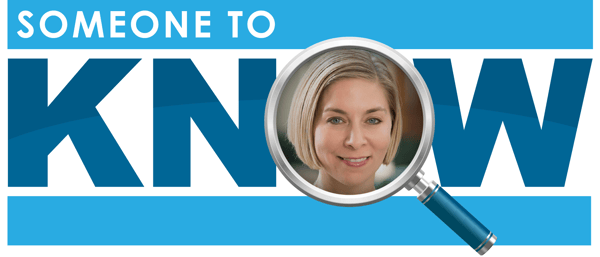Someone to Know: Q&A with Mars Wrigley Confectionery Senior Director of Strategic Business Communications Kristen Campos
Kristen Campos, Senior Director of Strategic Business Communications for Mars Wrigley Confectionery, has an undeniable superpower: she’s a master at navigating change. For that reason and several others, Kristen is definitely Someone to Know. The integration of the Mars Chocolate and Wrigley segments over the past year has brought a great deal of change to the organization, with more than 34,000 associates coming together under one global entity. Kristen has been at the center of the communications and strategy discussions for the newly formed business, and she has many insights into how communicators can best work with company leaders to carry forward a new strategic direction.

Q&A with Kristen Campos,
Senior Director of Strategic Business Communications
at Mars Wrigley Confectionery
Q: How is everything going for Mars Wrigley Confectionery?
A: Mars Wrigley Confectionery is essentially starting over. It’s a fresh new start for the combined businesses of the former Mars Chocolate segment and the former Wrigley segment, which has been a Mars segment since 2008. The new Mars Wrigley Confectionery business is now the world’s leading manufacturer of chocolate (SNICKERS®, M&M’S®, DOVE®, GALAXY®, MALTESERS® and TWIX®), gum and mints (DOUBLEMINT®, EXTRA®, ORBIT®, 5™ and ALTOIDS®, LIFESAVERS®) and fruity confections (SKITTLES® and STARBURST®). With that, we obviously have a new role to play as the confectionery industry leader, and we are creating a whole new strategy to drive growth for the category. This, in essence, becomes everything that we will base our messaging on and becomes a platform for everything related to internal communications and our leadership moving forward.
Q: I know your title is Senior Director of Strategic Business Communications. What does that mean? How do you see your role?
A: The bottom line is it’s not (just) about communicating. It’s about enabling the business. It’s about how do we move a strategy forward that will help the business grow, that will help the business achieve its strategy and its north star through the lens of communications? So, how do we crystalize a story around that business strategy? How do we help our associates understand what their role is in moving that forward, so really driving more of a contextualized and very relevant conversation so they are engaged and inspired to perform even better.
Q: Given that you’re sort of starting over in some ways, how are you thinking about this new day and how you’re going to approach it?
A: One of the challenges right now is that we have a traditional communications infrastructure that worked for the former two segments, but we are now a new business. While we are now beginning to move things forward in new ways—we still need new channels to better reach, inspire and engage people. Now that we’re 34,000 associates strong and no longer broken down the middle by two different segment organizations, we only know anecdotally which communications practices are working and which ones are not. To figure out what will work best in our “new world”, we recently deployed a holistic communications audit designed to give us insights about what our people want to know and how they want to consume the information. It is taking into account the thoughts and feedback from leaders, but more importantly, we’re looking at feedback from associates who span the world and all levels of the organization across all functions. We want to get a better sense of what is going to be the most effective way to get messages across to them, and how we involve them in our collective success as Mars Wrigley Confectionery. That will inform what we eventually create in terms of a longer-term internal communications strategy, which will define not only our channels but how we work with leaders to become more effective through communications, how we work with line managers to become more effective line managers, and then what technology we need to really advance our channels in the same way that successful brands engage consumers. The other great outcome of this audit is that we are giving our internal communications leaders across the business more opportunity to engage with their stakeholders to help them better understand the business in their unique areas of the world. This will build better business acumen, stronger relationships and a rock-solid local communications plan that aligns to what will drive business performance for their geography.
Q: Do you feel that there is also much that you’re able to build upon from a business and communications perspective?
A: I feel really fortunate that I work with some fantastic leaders who totally get it when it comes to engaging associates and are very open to counsel and very supportive of learning more about what our associates need to drive performance. That stems from our president, who really casts the right shadow to ensure associates are informed about the business strategy and know their role in achieving it. The other thing we’ve got is a great team of Corporate Affairs folks, which is the function where Internal Communications sits. We’ve just put into place all new teams and new responsibilities. We just started up a network of strategic business communicators, people from our markets, who we collaborate with on our audit and will certainly inform and co-create what our global internal communications strategy looks like. I really want to be open to try new technologies and new things, even though it might be a little scary and require some risk.
Q: Was there a defining moment or moments that helped your leaders really understand the power of communications as an enabler of the business?
A: I think it’s a matter of building trust and rapport, and it’s been multiple moments in time. When I reflect on my time with Mars, which is coming up on seven years, I happened to start with the business in a global internal communications role about the same time that our Wrigley president came on board. I think getting to know him, his style, and his vision for the business helped me. That was the starting place, and we’ve just been partners together ever since. I think having that seat at the table was earned and it continues to be earned. It’s not something you could just rest on your laurels with.
Q: What about your work gets you most jazzed every day?
A: I think recognizing that we’re really setting the course for what the future is going to bring in an entire industry, and also for our company. That gets me really excited, and as small as my role is, I know it’s an important role. You almost have to be comfortable with being behind the scenes but recognize the role that you’re playing to drive things forward because it’s about the business strategy and enabling leaders to tell that story.
Q: I know one of your superpowers is around change. Is there a principle or two as you embark on this next chapter that is especially top of mind as you think about helping people in the organization continue to see the future and what’s possible, and understand their role?
A: When I look at the amount of change that we’ve gone through over the last year and a half or so, it’s been quite substantial, and we are not done yet. While I think it’s very exciting to land a strategy and a story that we know will propel us into our future, I also think I have to stop and recognize the sheer amount of change that our organization has experienced and continues to experience—and the impact this has on each individual. I think the message really is that change is constant. You have to stop, recognize and thank people, and appreciate the progress along the way.
Q: Do you have any insights on your biggest challenges and how you maintain this very positive outlook that I am hearing from you?
A: I think the first thing that is important in business, any walk of business, is prioritization. It’s about taking a step back to understand what is going to drive value for the business. I think a lot of business people will operate in their silo and are very focused on the priority they need to deliver to the business, without understanding the bigger picture. Communications teams get pulled into a lot of initiatives that many people will perceive to be the top priority for the business when in reality they may just be the priorities of select individuals or teams. This is why it’s so important for Communications to genuinely understand the strategy of the business, to genuinely understand whether or not that person’s priority really needs to be a communications priority. One of the things I talk to my team about and others is the importance in communications of really great business acumen and not stopping on that business acumen journey. Things are constantly changing … and so should your learning and your agility. I think that’s number one ... understanding the business, the business strategy, and what’s going to drive real value.
Q: Does this mean that you tell your leaders directly when they’re working to communicate something that doesn’t line up with the business priorities?
A: One hundred percent. Yes, that was my next point, which is don’t be afraid to say no. I think one of the things that I did in my Wrigley days before we became part of the bigger Confectionery segment was look at business initiatives and business priorities through the lens of what people need to act on, what people need to know about, and what is just nice to know. Some of those nice-to-know things could be as easy as an intranet story. … Then, you look at those priorities that everybody needs to know about or everybody in the company needs to act on, and those are the things that you need to put more time against, more resource against, and more priority against. Those are the things that are going to require a more tailored communications approach.
Q: Can you give an example of something that you recently pushed back on?
A: I think most of this comes into play with my team. They’ll often come to me and say, so and so would like me to work on such and such, and I often will ask: what’s the value to the business, but also what are the channels we have today or the communication events in which we can tie certain things into? I’ll give you an example. One thing we’re starting right now is a monthly and then quarterly key business performance indicator; a template of sorts where we can show global, regional and country-level progress against the key business drivers and financial metrics that we want our associates to know about. It’s getting a lot of traction and visibility. So now, we don’t have to reinvent the wheel every time somebody comes to us and says we need a story on productivity or other initiatives. It is becoming an automated process for them and they know this one metric, this one number that they are responsible for, will be updated and sent to all associates on a regular basis, and at a regular frequency and will get the visibility that they are looking for.
Also, we are looking at how we can upskill leadership communication capabilities so that many leaders are more proficient in understanding how they personally can impact performance and change against their key initiatives. It’s a work in progress, but we aim to help leaders to become more self-service and know how their function needs to operate under the global, big-picture strategy. I think the name of the game, in a certain respect, is teaching them how to fish.
Q: Thank you so much for your insights today. Is there anything that we hadn’t talked about that you want to make sure that we covered?
A: What struck me about your questions was just how appropriate they are in this current stage of our business, the amount of change we face, and the constant change. I think the one thing I am continuously learning is that change is never ending. If you want to be successful in the face of change, it’s important to understand the business, gear communications to advance the business strategy—and of course to stop and recognize the progress, and celebrate that progress with those who are making it happen!
----

Kristen Campos is Sr. Director, Strategic Business Communications for Mars Wrigley Confectionery, a segment of Mars, Inc. Mars Wrigley Confectionery are the makers of chocolate, gum, mints and fruity confection brands you know and love such as M&M’S®, Snickers®, Dove®, Galaxy®, and Twix® Extra®; Orbit®, Doublemint®, 5™, Juicy Fruit® and Eclipse®; Altoids® and Life Savers®; Skittles® and Starburst® and many more. Kristen and Marco, her husband, live in Chicago and are proud parents to A.J., age 16 and a new driver (look out!) and Nina, age 9 going on 16. In her limited downtime, Kristen enjoys Pilates and cooking for friends and family.
To read more executive Q&As in our Someone to Know Series, click here.
Click below to download The Mistakes CEOs Can’t Help But Make…And the Fixes They Can’t Afford Not to Make, and get an actionable guide to help you find out what you need to do to make your strategy a reality:

Comments on this post